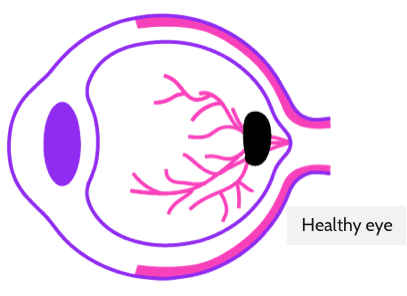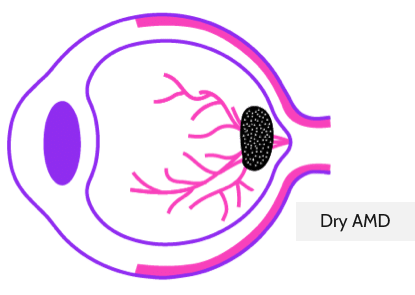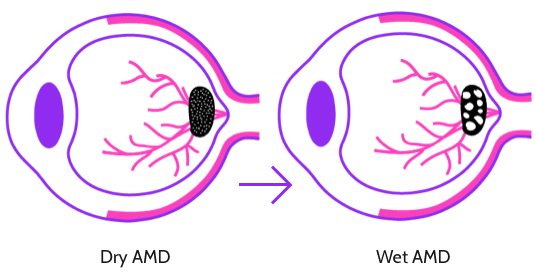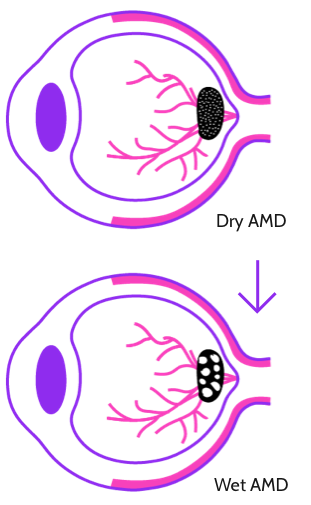
Age-related macular degeneration
Understanding age-related macular degeneration1
Age-related macular degeneration (AMD) is an eye condition that can affect your vision over time.
As the leading cause of vision loss in people aged 60 and over, it’s important to know which signs to look out for.
If you’re concerned about yourself or a loved one, talk to your doctor and scroll to find out more.
Here are some of the key terms we use when talking about AMD:
- Age-related
AMD is the leading cause of vision loss in people aged 60 and over. - Macular
It affects a part of the eye called the macula, which is responsible for central vision. - Degeneration
AMD progresses slowly over time though the speed can change according to which type of AMD you have.
- Dry AMD
This is the early stage of AMD that progresses slowly over time. - Wet AMD
This is otherwise known as neovascular AMD. 10% of dry AMD cases will become wet AMD, a condition that progresses quickly. - Central vision
The part of your vision you use to focus clearly on something directly in front of you, like reading a book.
Symptoms of AMD2,3
During the early stages of AMD, you can experience a range of symptoms.
While symptoms may vary from person to person, they’re usually a combination of
those shown below:
Risk factors of AMD4,5
AMD isn’t caused by any one particular thing. Instead, it’s a combination of risk factors:
How does AMD affect the eye?
Two types of AMD1,3,6
There are two main types of AMD:
Dry
AMD
The early stage is called dry AMD.3
Wet
AMD
The later stage is called wet AMD, otherwise known as neovascular AMD (nAMD).1,6
It’s important to note that not everyone will go on to develop wet AMD.
Dry AMD1,3,6
The most common type of AMD is dry AMD.
How does dry AMD develop?

In dry AMD, debris builds up in an area at the back of the eye called the macula. This build-up can lead to vision loss over time.

The early symptoms of dry AMD can often be confused with ordinary signs of aging since they progress so slowly. However, at its worst, dry AMD can result in blank patches in the centre of your vision.
Wet AMD1,3,6
If left untreated, dry AMD can progress into wet AMD.
In fact, around 10% of people with dry AMD will experience this.1,6
10%
of people with dry AMD will experience wet AMD


How does wet AMD develop?1,3,6
- Wet AMD begins when abnormal blood vessels grow in the eye.
- These tiny vessels can start to leak and damage vision.
There are ways to treat wet AMD but, if left untreated, it can lead to irreversible vision loss.
References
1. Bright Focus Foundation. Age-Related Macular Degeneration: Facts & Figures. [Internet; cited March 2021]. Available from: https://www.brightfocus.org/macular/article/age-related-macular-facts-figures
2. Bright Focus Foundation. Macular Degeneration Essential Facts. [Internet; cited March 2021]. Available from: http://www.brightfocus.org/macular/news/macular-essential-facts
3. Kellogg Eye Center. AMD. [Internet; cited March 2021]. Available from: http://www.kellogg.umich.edu/patientcare/conditions/amd.html
4. National Eye Institute. Facts About Age-Related Macular Degeneration. [Internet; cited March 2021]. Available from: https://nei.nih.gov/health/maculardegen/armd_facts
5. Bright Focus Foundation. Macular Degeneration Prevention and Risk Factors. [Internet; cited March 2021]. Available from: http://www.brightfocus.org/macular/prevention-and-risk-factors
6. NHS Choices. Macular Degeneration. [Internet; cited March 2021 Available from: https://www.nhs.uk/conditions/age-related-macular-degeneration-amd/getting-diagnosed







